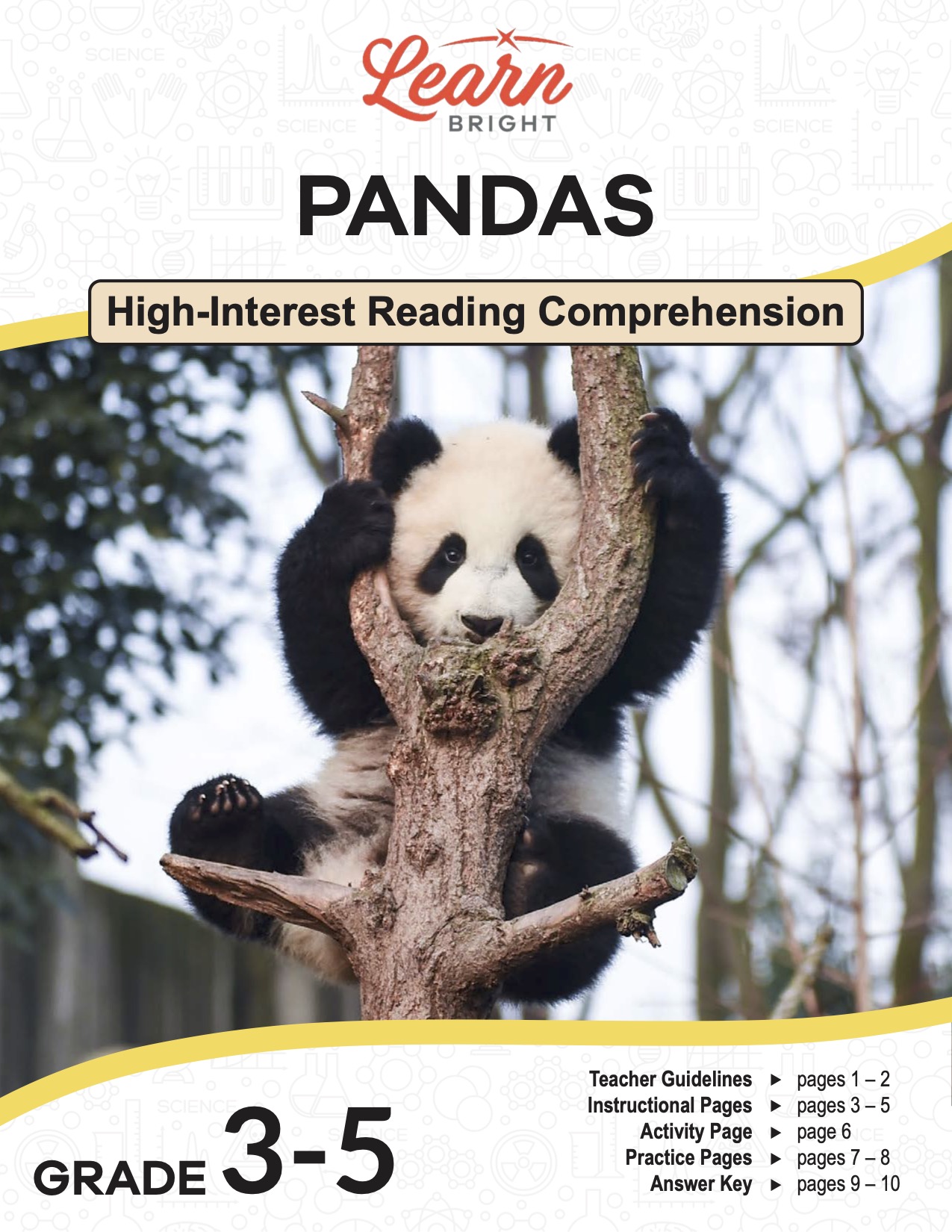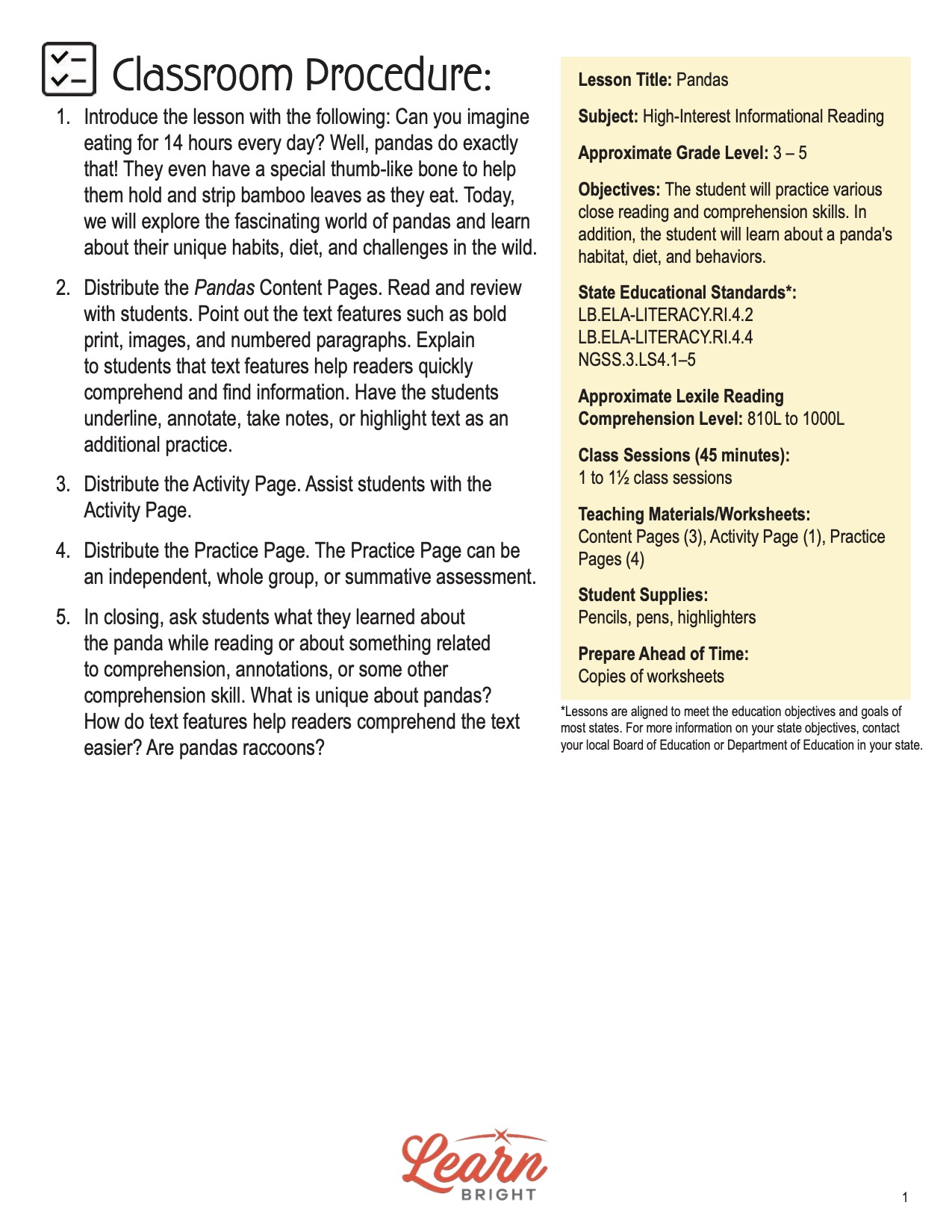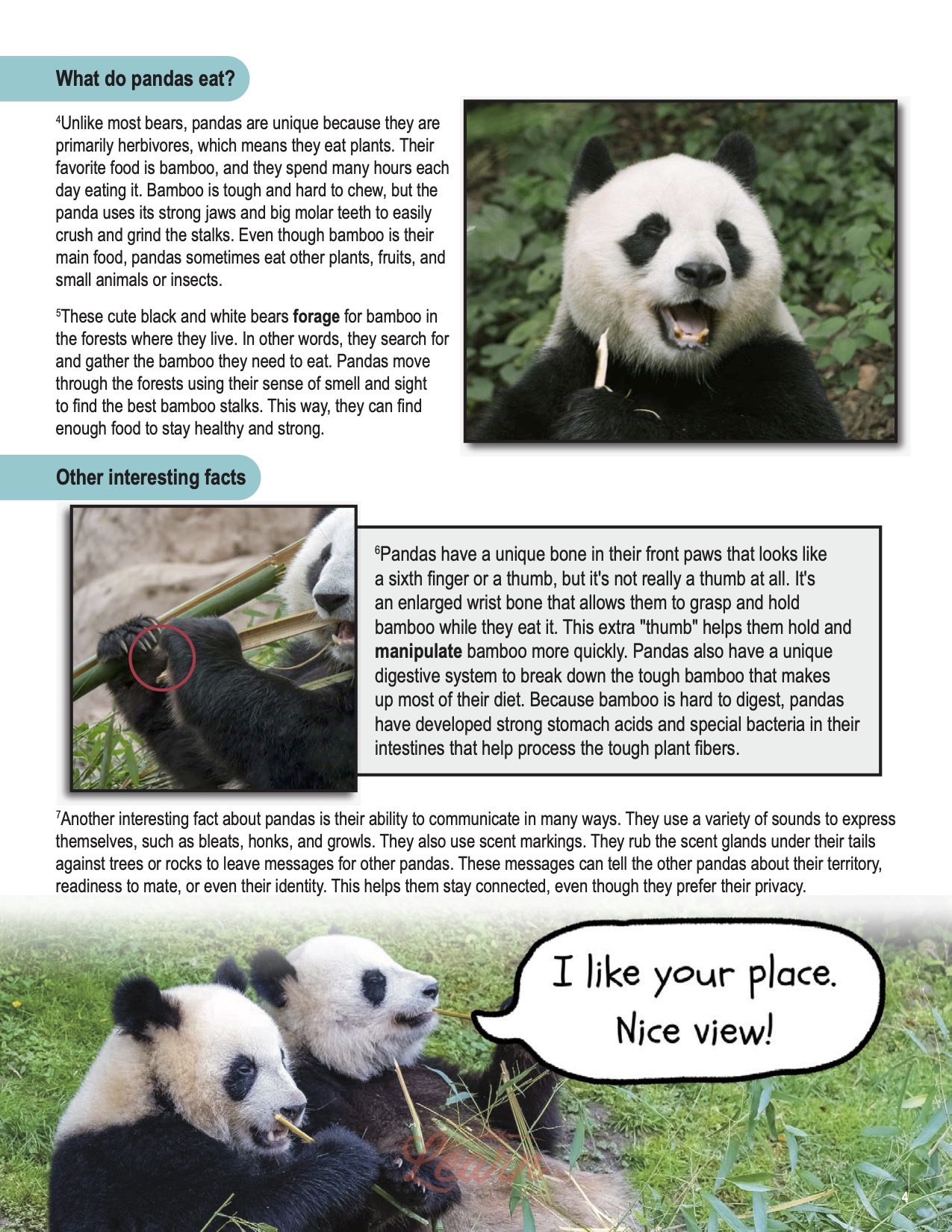Description
What our Pandas lesson plan includes
Lesson Objectives and Overview: Pandas is a high-interest reading comprehension lesson plan. As such, students will practice various close reading and comprehension skills. In addition, they will learn about the panda’s habitat, diet, and behaviors. This lesson is for students in 3rd grade, 4th grade, and 5th grade.
Classroom Procedure
Every lesson plan provides you with a classroom procedure page that outlines a step-by-step guide to follow. You do not have to follow the guide exactly. The guide helps you organize the lesson and details when to hand out worksheets. It also lists information in the yellow box that you might find useful. You will find the lesson objectives, state standards, and number of class sessions the lesson should take to complete in this area. In addition, it describes the supplies you will need as well as what and how you need to prepare beforehand.
Teacher Notes
The teacher notes page provides an extra paragraph of information to help guide the lesson and remind you what to focus on. It explains that you can teach this lesson in a whole-class setting or as an independent, small-group activity. The blank lines on this page are available for you to write out thoughts and ideas you have as you prepare the lesson.
PANDAS LESSON PLAN CONTENT PAGES
All about Pandas
The Pandas lesson plan contains three content pages. To start off, it provides a small box with basic background information about pandas. Pandas are unique animals known for their distinct black and white fur. They have round white faces with black patches around their eyes. The black circles around their eyes help them hide in the forest and recognize other pandas. These circles also make their eyes look bigger, which can scare away animals that might want to bother them. Pandas have thick fur that keeps them warm in the cool, mountainous regions where they live. They are also quite large. Adults weigh between 220 to 330 pounds and reach up to 6 feet in length, making them one of the largest members of the bear family.
Pandas live in the dense bamboo forests of China. The forests provide the perfect environment for the bears, offering plenty of bamboo to eat and trees to climb. Pandas are usually solitary animals, meaning they prefer to live alone rather than in groups. Each one has its own territory, which it marks with scent to keep other pandas away. However, they do come together during the mating season in the spring.
When it comes to caring for their young, pandas make great mothers. A baby panda, called a cub, is born very small. A newborn cub weighs three to five ounces and is about the size of a stick of butter. The mother keeps her cub in a safe den, where she nurses and protects it. The cub depends entirely on its mother for the first few months, drinking her milk and staying close to her for warmth and safety. As the cub grows, the mother teaches it how to find and eat bamboo. The mother panda always ensures her cub gets the care and skills it needs to survive in the wild.
What They Eat
Unlike most bears, pandas are unique because they are primarily herbivores, which means they eat plants. Their favorite food is bamboo, and they spend many hours each day eating it. Bamboo is tough and hard to chew, but the panda uses its strong jaws and big molar teeth to easily crush and grind the stalks. Even though bamboo is their main food, pandas sometimes eat other plants, fruits, and small animals or insects.
These cute black and white bears forage for bamboo in the forests where they live. In other words, they search for and gather the bamboo they need to eat. Pandas move through the forests using their sense of smell and sight to find the best bamboo stalks. This way, they can find enough food to stay healthy and strong.
Interesting Facts about the Panda
Pandas have a unique bone in their front paws that looks like a sixth finger or a thumb, but it’s not really a thumb at all. It’s an enlarged wrist bone that allows them to grasp and hold bamboo while they eat it. This extra “thumb” helps them hold and manipulate bamboo more quickly. Pandas also have a unique digestive system to break down the tough bamboo that makes up most of their diet. Because bamboo is hard to digest, pandas have developed strong stomach acids and special bacteria in their intestines that help process the tough plant fibers.
Another interesting fact about pandas is their ability to communicate in many ways. They use a variety of sounds to express themselves, such as bleats, honks, and growls. But they also use scent markings. They rub the scent glands under their tails against trees or rocks to leave messages for other pandas. These messages can tell the other pandas about their territory, readiness to mate, or even their identity. This helps them stay connected, even though they prefer their privacy.
Pandas also have interesting sleeping habits. Unlike some animals with specific sleeping times, pandas take naps throughout the day and night. They sleep about two to four hours and then wake up to eat more bamboo. This napping schedule helps them conserve energy and maintain their strength. Digesting bamboo requires a lot of energy. Pandas are excellent climbers, so they often find a comfortable resting spot in the tress to sleep. Plus, they can stay safe from predators.
Why Are Pandas Important?
Pandas are very important for the environment because they help keep bamboo forests healthy. Eating large amounts of bamboo helps control these plants’ growth, allowing other plants and animals to thrive in the forest. When pandas move around and forage, they also help spread bamboo seeds through their droppings. This creates a healthy and balanced ecosystem.
Sadly, pandas are considered an endangered species, meaning there are not many left in the wild. Only about 1,800 pandas live in the wild. They face threats like habitat loss due to deforestation and climate change, making it harder to find enough bamboo to eat. To help protect them, many organizations are working to save their habitats and create nature reserves where pandas can live safely. Breeding programs in zoos also help increase the panda population. By protecting them, we also protect their entire ecosystem, which benefits many other plants and animals.
PANDAS LESSON PLAN WORKSHEETS
The Pandas lesson plan includes two worksheets: an activity worksheet and a practice worksheet. Each one will help students solidify their grasp of the material they learned throughout the lesson. You can refer to the classroom procedure guidelines to know when to hand out each worksheet.
HELP THE PANDAS ACTIVITY WORKSHEET
This activity requires some researching. Students will find information about why pandas are in danger. They will look up a conversation group that helps pandas. Then they will fill in the table using the info they find about pandas according to the conservation group’s data. For instance, they will write the group’s mission statement and their unique strategies for helping the panda population.
PANDAS PRACTICE WORKSHEET
The practice worksheet requires students to answer a series of 11 questions. These questions all relate to the content pages, so students will need to refer to them often for the answers. In addition, each question provides which reading tool the question corresponds to, such as text feature, vocabulary, or comprehension.
Worksheet Answer Keys
At the end of the lesson plan document is an answer key for the practice worksheet. The correct answers are all in red to make it easier for you to compare them with students’ responses. If you choose to administer the lesson pages to your students via PDF, you will need to save a new file that omits these pages. Otherwise, you can simply print out the applicable pages and keep these as reference for yourself when grading assignments.









